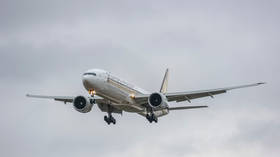
Passengers were launched into the ceiling when the Singapore-bound jetliner plunged 6,000 feet in minutes

A Singapore Airlines Boeing 777 aircraft approaches London Heathrow Airport in August 2022 © Getty Images / Nicolas Economou
One person was killed and several others were injured when a Singapore Airlines flight from London encountered severe turbulence en route to Singapore on Tuesday. The Boeing 777 was forced to divert to Bangkok.
Singapore Airlines flight SQ321 departed Heathrow Airport on Monday night with 211 passengers and 18 crew on board. As the plane crossed the Bay of Bengal near Thailand on Tuesday, it was stricken by “severe turbulence” and forced to land just before 4pm local time, the airline said in a statement.
“We can confirm that there are injuries and one fatality on board the Boeing 777-300ER. Singapore Airlines offers its deepest condolences to the family of the deceased,” the statement read.
Data from FlightRadar24 showed the widebody jet dropping from 37,000 feet (11,278 meters) to 31,000 feet (9,449 meters) in around three minutes as it neared the Thai coast.
READ MORE: Police name cause of Boeing whistleblower’s death
“Suddenly the aircraft starts tilting up and there was shaking so I started bracing for what was happening, and very suddenly there was a very dramatic drop so everyone seated and not wearing a seatbelt was launched immediately into the ceiling,” passenger Dzafran Azmir told Reuters.
“Some people hit their heads on the baggage cabins overhead and dented it, they hit the places where lights and masks are and broke straight through it,” Azmir said.
Photos apparently taken after the jet had landed showed the cabin strewn with rubbish and some passengers and crew members with visible injuries.
Singapore Airlines flight Boeing SQ321 fell from 6000 feet due to turbulence 1 person died and several injured Always have your seat belts when inflight #SingaporeAirlines#SQ321pic.twitter.com/Yta1iylDOD
— Sidra (@SidRa18350) May 21, 2024
Turbulence is an unpredictable phenomenon with multiple causes. Rolling air currents passing over mountain tops, jet streams, and tropical storms can all disrupt calm air and cause turbulence. The US National Oceanic and Atmospheric Administration (NOAA) classifies four levels of turbulence ranging from ‘light’ to ‘extreme’. In ‘severe’ cases of turbulence, “the aircraft experiences abrupt changes in altitude and/or attitude, and may be out of the pilot’s control for short periods,” according to the NOAA.
While modern airliners like the Boeing 777 are designed to withstand even ‘extreme’ levels of turbulence, it can still be hazardous to passengers who aren’t wearing seatbelts. Last August, 11 people were hospitalized after a Delta Airlines flight from Milan to Atlanta ran into severe turbulence while descending through a thunderstorm over Georgia, and between 2009 and 2021, the US Federal Aviation Administration recorded 146 serious injuries as a result of turbulence.
Singapore Airlines’ last fatal accident occurred in 2000, when one of its Boeing 747s crashed while attempting to take off from a closed runway during a typhoon at Taiwan’s Chiang Kai-shek Airport; 79 passengers and four crew members were killed when the jet collided with construction equipment parked on the runway.




